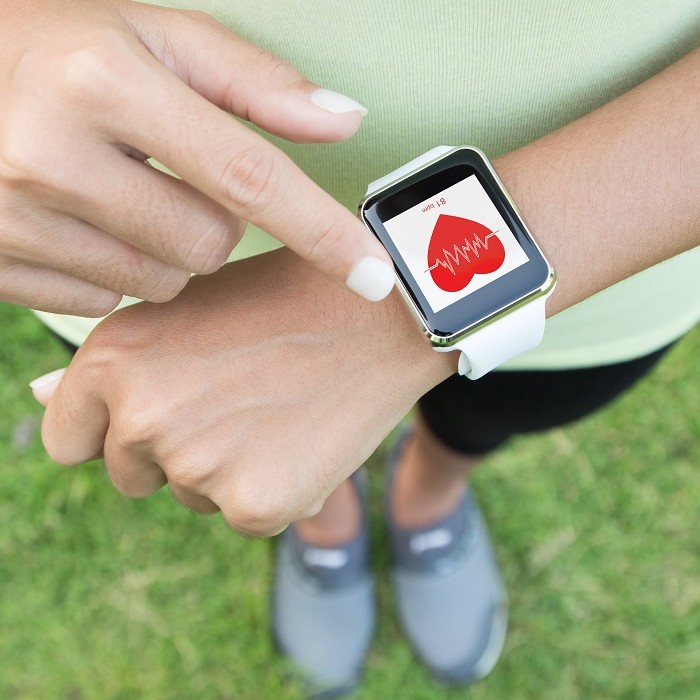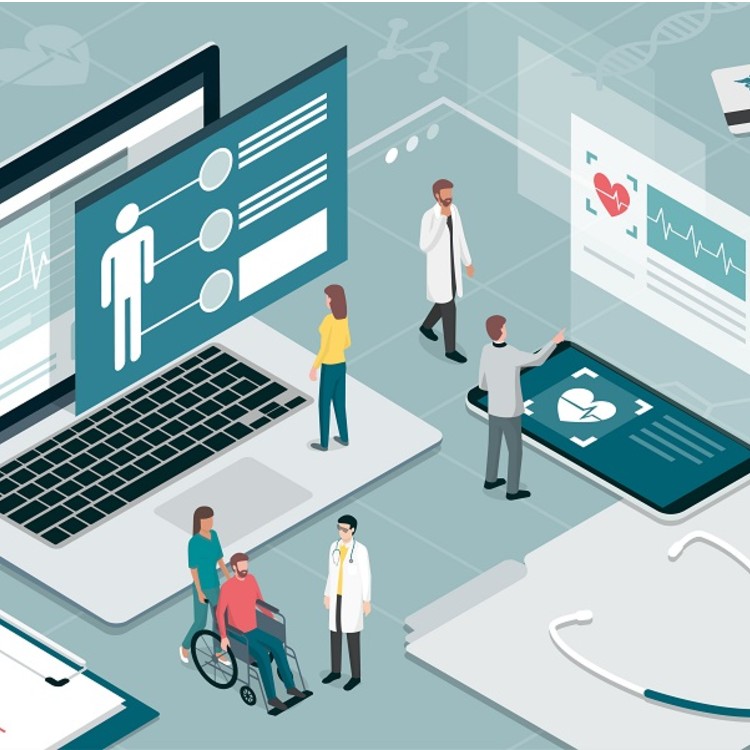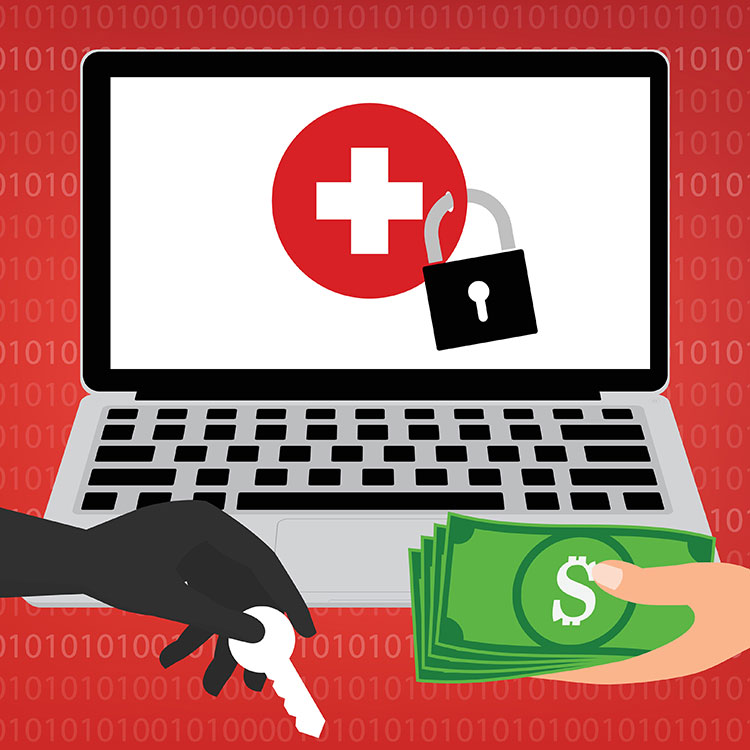U.S. healthcare expenditures are expected to reach $6.2 trillion by 2028. Still, many CIOs can’t shift their healthcare IT systems fast enough to modern technologies that are proving to benefit providers and patients, according to Geoffrey Bakeman, vice president of Healthcare Solutions at Comport Consulting Corp.
His firm works with providers to move the patient care needle forward through modern uses of healthcare IT solutions such as cloud and as-a-service technologies. He said what's keeping the CIO up at night are not the proactive things that can make medicine better. Instead, it's all the myriad of things needed to just keep the lights on.
In this Tech Barometer podcast segment, Bakeman takes listeners into the world of healthcare IT. That’s where 30% of the world’s data volume is created, according to RBC Capital Markets, and it’s growing at about a 36% annual clip – faster than manufacturing, financial services and media/entertainment.
But the recent Enterprise Cloud Index survey of healthcare IT professionals showed that healthcare organizations are still in the early phases of cloud adoption, lagging behind other industries. Results did indicate healthcare IT’s use of cloud computing could jump from 27% to over 50% in the next three years, aligning with the global trend of evolving to a multicloud IT infrastructure that spans a mix of private and public clouds.
Bakeman said part of this lag comes from the security and regulatory compliance challenges. CIOs that are further along their digital transformation keep “most healthcare data in a hybrid cloud, with the patient data on-premises.”
If harnessed properly, Bakeman said medical data can facilitate R&D breakthroughs, advance preventative medicine and slash the cost of healthcare delivery. A beacon of hope lies in virtualized infrastructure and data management tools that enable interoperability among disparate systems and automate much of IT operations.
He talked about a mission-critical project to modernize IT for Federally Qualified Health Centers (FQHCs) in underserved markets, which streamlined and enhanced the IT engine and network at Delaware Valley Community Health in Philadelphia.
Bakeman said that since the DVCH success, he’s attempting to help other FQHCs make similar moves and “put more money in the coffers for nurses, doctors, clinicians and a better patient experience” to help enable health equity throughout the U.S.
He also talks about fighting ransomware, data protection, technologies like virtual desktop infrastructure (VDI), IT automation and the quest for interoperability.
Transcript (unedited):
Geoff Bakeman: Well, what's a cloud. What's a cloud I can tell you right now, a CIO and a C-suite and a CEO are still responsible for PHI. If you take that data and you put it out and that data gets hacked, they are physically responsible and could be found, go to prison. You'll find that most patient data is still in a hybrid cloud on-prem. PHI… very few hospitals put that in a remote cloud, managed by an MSP. They don't trust it. It's still in a hybrid cloud on-prem.
Jason Lopez: That's Geoff Bakeman vice president of healthcare solutions for Commport Consulting. And what he's referring to in this opening comment is PHI, personal health information. It's one of the many complex factors in why the US healthcare industry seems behind the digital curve. In an earlier story, we did on the tech disruption of healthcare or more accurately, the lack of tech disruption., our sources pointed out that the business model of charging a fee to treat disease, needs to shift, to charging a fee to keep you from getting a disease. Technology is an important factor in that shift… the use of artificial intelligence to scan x-rays, wearable sensors, algorithms that search out and prevent surprise bills to customers. This is all cool stuff that’s slowly shifting the business model. But one facet of tech’s impact on healthcare we don’t hear much about in the news is large backend technology implementations… how data is stored, how it's accessed. This is where we turn to an expert like Jeff Bakeman who works with hospitals, in this story he talks about the work he’s done for Federally Qualified Health Centers, also known as FQs, doing enterprise tech. I started off by pushing back a bit and asking him why we're not seeing big advances in healthcare with all the amazing tech tools that are out there.
Geoff Bakeman: So I don't, I don't take that as a pushback at all. I would say, where are we with diabetes in healthcare? Where are we with cancer? Where are we with Alzheimer's? Where are we with cardiology? Where are we with our body mass index? We hear we're moving the needle forward, yet I still lost my mother to Alzheimer's. So what's changing. So if you look at us as a 3 trillion GDP, 20, 25 percent that's healthcare, this is a massive number. We have 5,000 hospitals in the United States. That's going to be about 2,500 hospitals by 2025. So what you're finding is it's not that the care and the improvement are not going forward. It's that this is 25 percent of our GDP. And it's so large. How do you get something out there that is changing and show it to people, right? So our play is to make a difference, make a small difference and figure out how to scale that difference. So that if I can get one FQ successful, then I can get 10. Then I can get a hundred. I'm going to make a difference. Even if it's small against a GDP number of 25 percent.
Jason Lopez: Right. Well, we wonder why the Air BnB or Uber of health care hasn’t arrived yet… where’s the tech disruption we've seen in other verticals. But as someone who sees under the hood what's your sense of this?
Geoff Bakeman: You know, healthcare has always been five to seven years behind Wall Street. You know, the financial institutions that know to the second, when to buy and sell their algorithms and everything they've created is far more advanced. And healthcare has always lagged behind and been very conservative. The problem we have now is how effective can a C-suite be to go to the proactive side of the equation, fighting a horrible battle of ransomware, mergers, and acquisitions, a pandemic doctors and nurses wanting to leave the field because they're burned out and stressed out right now. You can't get to the smart side of the equation. This reminds me of California, no rain, tons of fires. And they can't put the fires out. That's what's going on in healthcare right now. We have the technology. We have the AI, we have a lot of these things, but if you look, at what's keeping the CIO up at night, it's not the proactive things that are going to make medicine better. It's just keeping the doors open.
Jason Lopez: And I think one common perception is when information technology does ripple through the industry will feel it immediately on the consumer side in other words we'll see it on our iPhones. And that's probably true to a degree but you're witnessing advances that we don't necessarily as consumers see which could which are transforming medicine.
Geoff Bakeman: So we've now deciphered the human genome. We know that the genome is going to tell us how to turn off cancer, how to turn off various illnesses and mutations, that form illness and sickness, right? And we have a bunch of brilliant PhDs all over the world that have done their own studies on the genome and their data resides in their own research lab at Illinois or U Chicago or Harvard. Now, what happens is if I could virtualize that data and I could make all of professor A's data available to professor B's data and professor C's data and all of that genomic content goes into a single data lake where all the data sits in one place. What happens to the discovery of disease? Now the Corpus data come 3, 4, 10 times deeper than it was before, becoming much richer than before. That is when you're going to see the elevation. Just go insane with discovery because you can't just move this data around. It's petabytes. So petabyte here, petabyte there, petabyte there when you virtualize that and all that data, but comes virtually in one single location and you can get then play with it. What happens then? That's when you're going to see outcomes change drastically.
Jason Lopez: In this conversation with Jeff Bakeman, it's important to note the environment that he's talking about. There are about 14,000 Federally Qualified Health Centers in the United States. Many of them are nonprofits located in inner cities. They're understaffed. Their patients tend not to be affluent. And the IT at these hospitals tends to be resource-challenged as well. What Bakeman has done at an FQ in Philadelphia -- Delaware Valley Community Health – has shown how a new enterprise tech install increases patient visits and outcomes, and pays for itself by handing doctors and nurses more time to treat people.
Geoff Bakeman: This is really pretty cool. So we have an FQHC in Philadelphia, Delaware Valley, community health. They didn't have a strong network there. We built technology for an entire guest service where now not only can people say don't at that, you have an appointment today, right? So patient experience now has other things included in it, including texting and other items to remind people to come. But also when they get there, now there's a kiosk in there. And guess what? There's a human by the KIOS or they can use their phone and they can say, hi, bill Jones, I'm here. I'm ready to see my dentist. Or I'm here to see my clinician or what have you. And the FCC grants that were given out in the cares act money and the various funds that were out there. There was a huge FCC grant. We got technology. And yet that's another growth area for these guys. And that is to have the bandwidth to can support this growth. So Delaware valley has 10 locations. I have three data centers inside here, and we're on active, active, active, which means if the building catches on fire goes down. I have a hundred percent of the data accessible at all times prior to the pandemic going of Charles river, a, a truck hit a telephone pole. They were down for two days. So you're in an underserved community. They don't have redundant power. They don't have another location in another state. A clinician has no access to the EHR patient. Can't get in. You can't admit or discharge. Well, what are you going to do about that in the case of Philadelphia, which we're going to replicate in this video that we're doing, we're going to show you how we build a Nutanix back to back to back situation. And if a building burns to the ground or a telephone pole gets in my entire EHR, the workload goes through another location. I'm up and running my patient records in there. And I'm up with no downtime.
Jason Lopez: The video Bakeman refers to is something he put together to document how this implementation is moving the needle forward for a hospital system without much of an IT pedigree.
Geoff Bakeman: So what we did is we put NextGen on Nutanix. Well, the first thing that came out of this was you never touch it again. You don't manage it. You don't have to touch it. But I got a CIO to log in to the CIO of Delaware valley. And they're using next Jen from an MSP in the cloud. So Delaware valley is on-prem. And this CIO in Boston is at an MSP in the cloud. So I said, you want to do a Teams meeting and let me run this to show you your EHR on Nutanix. And I'm going to show login times the times it takes a clinician to fill a prescription and then I'll move you from radiology over to another module. So I'll throw you around the modules and show you. So login time for the guy running the MSP was about three minutes. We're doing it in 11 seconds at Delaware valve. So we took a prescription that was initially seven minutes. And we're down to under two minutes. By the time a person actually has a prescription in hand. So this gets really deep into the revenue cycle, right? What does that free a doctor, a clinician up to do in their free time, multiply that by 365 days, a year? What does that do to your revenue cycle? Right?
Jason Lopez: Right and I can see what you mean by small changes over time having big impacts because this is a really complex thing. It's not just a matter of digitizing something and then seeing it on your phone. The whole back-end infrastructure that you're dealing with is incomprehensible to us mere mortals. And it's not necessarily the computer science that I'm talking about because what you're dealing with are organizations that don't fit a lot of the tech models we've come to know that are disruptive. How would you characterize the situation hospitals and health care providers face to introducing the kind of tech disruption if I can call it that, which you're doing?
Geoff Bakeman: Well, you got a limited budget. Some are for-profit, some are nonprofit, but at the end of the day, you only have so much money to go around. Look at the size of the organizations that are hit by ransomware. They're massive. So think about a hospital system. That's got 20 or 30 locations. They have to create a cyber environment that locks every single access point down, including every IOT device that's connected to the network. Those are infusion pumps, radiology machines, all of these machines are now on the network. Then you got your firewalls. Then you got your internet access. Then you got your ERP. You have every one of these access points and you going to plug every single hole or you're going to have to pay millions of dollars. That's the problem. It's a massive problem. So solving ransomware just by itself and at the same time, I'm competing for the same patient. How do you do, a better job with patient experience the next guy so that when you leave there, you have that four-star review. How do you give them an application? That's on their phone that wave finds them into the hospital, to their doctor down the hallway, to radiology, back to the doctor, to read the radiology report and then takes you right back to your car. And you never got law. Yeah, the cloud's a piece of it. Genomics is a piece of it, but patient experiences, how you're get reimbursed from the insurance companies, that's revenue I can count on in the short term to pay my bills.
Jason Lopez: Well coming out of the pandemic we've established at least a few things about tech having that impact on health care. Videoconferencing which has been around for quite a while has become an expected way of interacting, right?
Geoff Bakeman: Well, I think telemedicine's huge right now, right? If you look during the pandemic Delaware valley, another prime example, said they wouldn't have been in business. If we hadn't have created the environment. And basically, 90 percent of everything had to be done remotely.
Jason Lopez: What do you think is the biggest tech challenge to transforming healthcare? You've talked about factors that sort of limit things. There's a good reason there is no Uber of healthcare, overturning the paradigm. You touched on privacy laws as one of those limiting factors. But again what do you think is the biggest tech challenge?
Geoff Bakeman: Probably the biggest one is portability. You got an M&A that's moving 5,000 hospitals into 2000, 2,500. So you got this multi-trillion dollar M&A that's happening in the short period of time and medical records. Aren't the same, the proprietary. So you emerge and you do all this stuff. You know, you, you can't just slide these patient records. Yo, guess what? They're over here that becomes difficult. Now, going back to the digital front door. And one of the things I like about what we're doing there is when you take epic and then you take my chart and then you take an SDK or an API in my chart actually becomes on your phone and your records are there and you can pay your bill and you can find your doctor and you can find the hospital and you can find your specialist and all this, as more of that comes down to your hand, you have more and more control over your own data, right? And if you remember, years ago, you just prayed. Somebody could even pull your records when you went to the hospital or they'd say they didn't have them or some doctor gave you a folder and said, oh, you're moving to Illinois. Take this file with you. You know it. So when these truly become open, that's going to really help medicine.
Jason Lopez: Geoff Bakeman vice president of healthcare solutions for Commport Consulting. There's an excellent article written by Joanie Wexler entitled “Data Deluge Keeps Healthcare CIOs Up at Night.” Look for it on The Forecast page. It’s at theforecastbynutanix.com. This is the Tech Barometer podcast I'm Jason Lopez. Thanks for listening.
Jason Lopez is executive producer of Tech Barometer, the podcast outlet for The Forecast. He’s the founder of Connected Social Media. Previously, he was executive producer at PodTech and a reporter at NPR.
© 2022 Nutanix, Inc. All rights reserved. For additional legal information, please go here.










